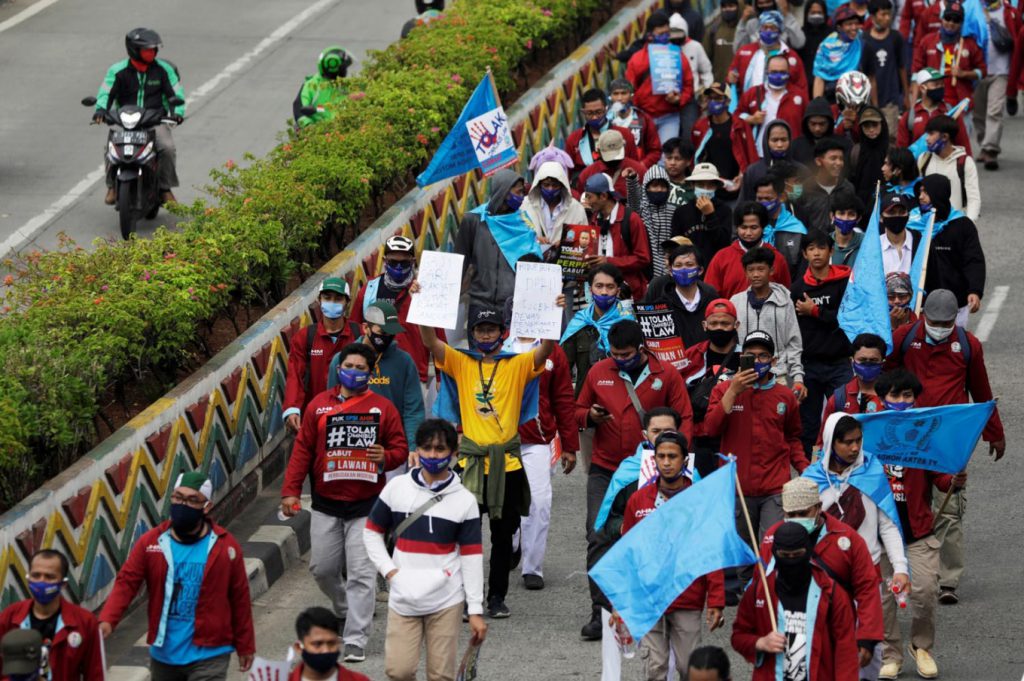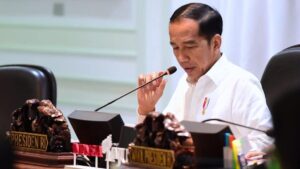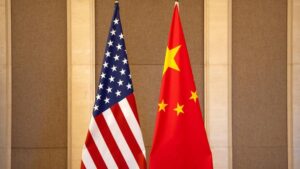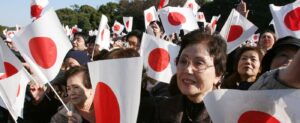Politics of the Labour Movement in Indonesia Today: National Strike and the Domination of the Aristocracy

Illustration of a national strike by Indonesian labor unions. Photo: Reuters/Willy Kurniawan
On 16 November 2021, Ministry of Manpower Ida Fauziyah announced that the average minimum wage increase in Indonesia is 1.09 percent. The amount of the minimum wage increase rate in Indonesia was determined based on a new regulation which is a derivative regulation of the Omnibus Bill package. The policy package was vehemently rejected by trade unions, peasants, and students last year. A new formula which, according to President of Konfederasi Serikat Pekerja Indonesia/Federasi Serikat Pekerja Metal Indonesia (KSPI/FSPMI—Confederation of Indonesian Trade Unions/Indonesian Metal Trade Workers Federation) Said Iqbal, is unconstitutional.
Since 2015, the scheme of wage increases no longer uses the Kebutuhan Hidup Layak (KHL—Dignified Living Needs) component as one of the basic reference materials. Politically, negotiation in the Dewan Pengupahan (Wage Council) of each region is weakening the position of labour unions. Historically, between 2003 – 2014 the KHL component has always been a core part of the tension conflict between labour unions and representatives of employers who sit on the Wage Council in negotiating the minimum wages.
This is what underlies the labour union calling for a national strike to be held on December 6 – 8, 2021. The call for strike was widely announced by Said Iqbal, President of KSPI/FSPMI. He explained to the press that there would be around two million workers going for a national strike, involving workers of 100 thousand companies and more than 60 trade union federations.
Besides KSPI/FSPMI, there was also the KASBI (Kongres Aliansi Serikat Buruh Indonesia/Congress of the Alliance of Indonesian Trade Unions) and the KPBI (Konfederasi Persatuan Buruh Indonesia/Confederation of United Indonesian Workers). Historically, these two confederations have represented themselves on the platform of the “left” trade unions. However, their members’ counts are still small when compared to the KSPI/FSPMI.
Starting from November, trade unions had mobilized protests in several cities, targeting government offices as a means of warming up the national strike. In Karawang, until the evening of November 23rd, workers were still crowding the regent’s office to force the relevant regional heads to agree to a 15% wage increase. It was also seen that workers at a factory in Brebes, Central Java, vented their anger by breaking down the factory fence.
The mass of workers gained more confidence after the Mahkamah Konstitusi (MK-Constitutional Court) decided that the Job Creation Law was formally flawed. The MK’s decision has legitimized the labour movement that demands the repeal of Government Regulation 36/2021 that resulted in a very low wage increase. This demand is in contradiction to the government’s statement in which Widodo said that the Job Creation Law remains in effect without any articles being annulled.
On the other hand, as reported by mass media in Indonesia, the Labour Party re-emerges after choosing Said Iqbal as a President after its first congress in October 2021. Regarding the party’s program, Iqbal explained that in 2021 – 2022, Labour Party has 14 political programs, one of which is to struggle for 2022 minimum wages.
As predicted by Lane’s commentary, the emergence of a new political party such as the Labour Party will raise a possibility of policy debate. This would provide a breath of fresh air for political contestation in post-Suharto Indonesia, which is thick with populist rhetoric and only focuses on individual personalities. So far, Lane’s prediction is correct. Yet, would the mass workers gain their victory in a politics of wages that they raised just recently under Iqbal’s leadership by using mass mobilisation or strike as seen lately?
Predictably, minimum wages will continue as one of the powerful issues to mobilize the worker’s movement in the future. Showing by Tadjoeddin and Chowdurry (2019), before 2009 inequality manifested on the gap between employed and unemployed. After that, unemployed workers are now employed with a huge increase in numbers. But they enter into the circumstance of low-paid formal sector employment or vulnerable employment. This condition will make the workers feel more insecure after the Omnibus Bill is passed. Giving the possibility of spontaneous resistance in the future.
By using the theory of labour aristocracy, the writer will analyse the possibilities in the future about the politics of the labour movement in Indonesia. The theoretical framework of labour aristocracy was first explained by Marx and Engels. In 1914 Lenin took this theoretical framework to analyse the British labour movement in a time of radicalization. To contribute to the discussion of Lenin’s thought, Hobsbawn (2012) gives a very clear explanation about that theory.
According to Hobsbawm, labour aristocracy has a different political purpose with the workers. The purpose lies in the need for the aristocracy to negotiate a concession with ruling class elites. Oftentimes, it is not always harmful towards worker’s conditions. But the aristocracy of the union usually offers a personal demand to the elite of the ruling class as the main political interest.
The condition’s objective is to support the existence of labour aristocracy. In which capitalism makes it possible to make concessions disproportionate to the challenges of the working class. Due to this effect, the aristocracy can inject a pseudo-consciousness into its working-class members that there is no need to fight politically by simultaneously running daily political activities such as education and consolidation. In the end, the worker movement is only a means to serve the aristocracy of the trade union’s personal interest.
An Aristocracy of Labour Domination
It is important to know that after the radicalisation of the labour movement in 2010 – 2012 (Rizaldi, 2021), KSPI/FSPMI has become the largest labour union in Indonesia. This kind of objective condition implies that their political movement is too big to be denied by the ruling class. The exclamation of strike has been proven to be effective to force the elites of the ruling class such as ministry or governor in a particular province to meet and negotiate with leaders of union, discussing the union’s demand. But, the opportunity arises, distracting from the original plans which aim to solve the root problem for the union itself.
In 2012, there was strong evidence that showed opportunism within the KSPI/FSPMI union leader. At that time, the national strike was stopped undemocratically by Iqbal on the first day. While a large number of workers came to the streets, Iqbal met with the Ministry of Manpower demanding the abolition of the outsourcing system. After the workers stopped the strike, the demand for removing the outsourcing system was unrealized.
According to Lane (2019) in his latest book, An Introduction to the Politics of the Indonesian Union Movement, leftist figures in Indonesia such as Danial Indrakusuma and Sherr Rinn played a significant role in educating and organizing workers at that time. However, this kind of activity has been undemocratically stopped by the elites of the labour union after the Deklarasi Harmoni Industri Bekasi (Bekasi Industrial Harmony Declaration) happened. FSPMI—the federation where Danial and Sherr Rinn works ‘expelled’ them in April 2013 without a formal public statement. Since that time, there is no politic and economic education in KSPI/FSPMI anymore.
In 2015, the alliance of Gerakan Buruh Indonesia (Indonesian Labour Movement) which consists of the KSPSI, KSBSI, KSPI, and KP KPBI held a press conference at Hotel Mega Proklamasi. In that press conference, they declared, “…will unite against RPP Pengupahan (Draft Government Regulation on Wages) … will start with the warming up protest and prepare the third national strike 2015 by mobilising 2-3 million workers to shut down the tools of production and all industrial areas in Indonesia”. This exclamation turned the strike into a rally—changing the method of struggle and reduced the essence of the strike.
It is not surprising that worker union leaders so easily call the national strike. The root of explanation is not about their leader having the same consciousness with the workers. Instead, most members in trade unions are still under the grip of the labour union aristocracy.
Back to the history of labour radicalisation in 2012, after educational activities ceased and progressive activists were expelled, the movement persisted only as spontaneous actions. This spontaneity was different from the movement that has emerged since 2008 and radicalized in 2010 – 2012. The workers built their power movement from below (Lane, 2014) by using the veergadering method to develop solidarity among workers.
In 2012, after the door of negotiation between union leaders and the ruling class was opened and the concessions were gained, the political movement needed to be stopped using harsh tools. Many members of the union who still wanted to continue the radicalisation were fired from their factory under the union’s support (secretly). According to Sherr Rinn’s explanation, centres of workers consolidation and member recruitment such as Rumah Buruh and Saung Buruh were closed by the union branch manager (district level), and they did not allow their members to join in inter-factory solidarity. These harsh tools were needed to maintain the domination of labour aristocracy.
In the article entitled “The missing new Indonesian Left—leftist amnesia”, Törnquist has explained,
“Until, that is, there was an opening to firstly negotiate labour and welfare reforms with popular local politicians in need of support to win elections, such as Jokowi, and secondly to build broad alliance with parliamentarians such as for the national health scheme.”
There is a vague explanation of the historical chronicle in Törnquist’s article. In fact, worker radicalisation in 2010 – 2012 did not happen because the labour union leaders suddenly called for general mobilisation to support policy negotiation to win the national health scheme. The facts show that the radicalisation of the labour movement started from factories, which emerged from the outsourcing system that made the workers feel restless. Mass mobilization such as occupying and sweeping the factory was used as a rough weapon to demand the improvement of worker conditions—to specifically abolish the outsourcing scheme.
Then the mass mobilisation got bigger and had good gripping qualities because the movement was developed by the workers on the factory basis. It was strengthened with the centre of worker consolidation to manage the gruduk pabrik (a tactic of workers solidarity among factories), strikes, and occupations of local government offices.
Furthermore, it was also reinforced by activating economic and political education facilities for workers as guides. The radicalisation that emerged from below made Iqbal see that the kind of strategy and tactic used by workers at the grassroots level is an effective tool to negotiate the national health scheme in 2012. While at the same time playing the political elite transaction for the general election in 2014. After gaining mass-based support for his political purpose and winning a significant wage increase for the workers, he, and the other elites from KSPI/FSPMI stopped grassroots activity harshly.
The contradiction between labour aristocracy versus labour activists at a grassroots level lasted until 2015. This is why the writer said that spontaneous radicalization is not vaporizing rapidly when compared to the workers’ radicalization against Omnibus Bill last year.
After the aristocracy won their political fight against radical activists inside the union, it was easy for the labour union’s elite to call for a national strike. However, the strike was overwhelmingly difficult to run at the grassroots level. The weakening of political activity at the grassroots level after 2014 directly impacted the condition of workers’ struggle today.
The Stagnation of Political Negotiation Using Exclamation of National Strike
From that history, the mass mobilisation method is proven to be an effective way to open the negotiation among labour union leaders and the ruling class. At least, this has been the mainstream tool since 2010. The broad alliances made for demanding the “equal civic, political and social rights” as proposed by Tornquist have been carried out in an infinite number of ways (2010-2021). Yet, at least since 2015, it has not made any qualitative progress on the politics of labour today. Instead, the situation further indicated a decline in power after the elites of the ruling class denied their demands.
It makes sense, because the domination of aristocracy must maintain the labour movement under their political interest, therefore, giving a certain limit on radicalization at the grassroots level. In other words, canalising the labour movement towards economism and spontaneity character. The working class who already become a member of the union are not allowed to control the organization to build a strong group from below and access the finances that are needed for the struggle. Under these conditions, a strike is only interpreted as an incitement from the labour union leaders. As a result, in this formula a strike will not occur. And the workers predictably will easily be defeated in a struggle of wages.
On the other hand, national strikes that were overwhelmingly difficult to execute already benefited the ruling class elite to run their undemocratic policies. It can be seen clearly when the huge mobilisation of workers in West Java this week did not shake Ridwan Kamil’s decision to use Government Regulation 36/2021 as a tool to decide the increase of minimum wages—which is a very small increase. Last year, Coordinating Minister of Maritime and Investment Affairs Luhut Binsar Pandjaitan responded that the exclamation of the national strike against Omnibus Bill by the unions was empty words. On December 7th 2021, the governor of Banten asked the entrepreneurs to fire the workers who resist the UMP. This evidence indicates that the elite of the ruling class are not afraid anymore of the ‘bluff’ of national strikes from the labour union elite.
It shows that the participation of workers in the political struggle is not enough by just joining the rally of protest when their labour union elite call for it. There also needs to be a revival of grassroots political activity that can accommodate their involvement in the struggle in a sustainable manner. In other words, reviving the activity of economic and political education by simultaneously organizing the consolidation.
The consolidation is supposed to be open for all workers. To open the door for workers to discuss their tactic and strategy to develop their struggle is essential as a foundation of strike. Workers themselves will learn from their political experience not only by joining the protest, but also mass meetings to develop their own political consciousness. Till now, there is just the labour union of Federasi Serikat Buruh Demokratik Kerakyatan (F-SEDAR—Popular Democratic Workers’ Union) who run education and mass consolidation routinely. There is nothing wrong for the members of KSPI/FSPMI to look at F-SEDAR as an alternative role model.
Reference:
Hobsbawn, E. (2012, December 1). Lenin and the “Aristocracy of Labor”. Mounthly Review, 2012, Volume 64, Issue 07 (December).
Lane, M. (2014). Unfinished Nation: Ingatan Revolusi Aksi Massa dan Sejarah Indonesia (1st edition ed.). Yogyakarta: Djaman Baroe.
Lane, M. (2019). An Introduction to the Politics of the Indonesian Union Movement . Singapore: ISEAS.
Mohammad Zulfan Tadjoeddin & Anis Chowdhurry. (2019). Employment and Re-Industrialisation in Post Soeharto Indonesia . London: Macmillan Publishers.
Törnquist, O. (2021). Part 2: The missing new Indonesian Left – leftist amnesia. New Mandala.
Wicaksono, R. A. (2021). Peran Partisipasi Publik dalam Pembuatan Kebijakan (Undergraduate Thesis). Yogyakarta: Fakultas Hukum, Universitas Islam Indonesia.
Farhan Syahreza is a Law student from Universitas Islam Indonesia. He can be found on Instagram with the username @syrz.5





